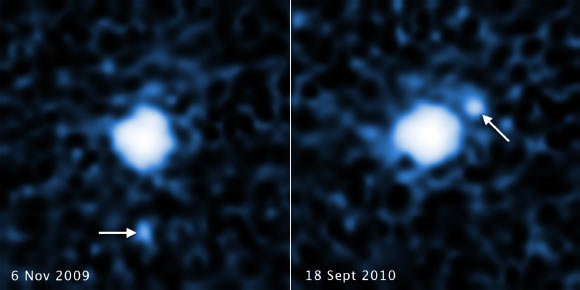Using the NASA/ESA Hubble Space Telescope, NASA’s Kepler and Herschel space observatories, astronomers have discovered a new moon in our Solar System, orbiting a dwarf planet called (225088) 2007 OR10 (2007 OR10 for short). The small moon is estimated to be about 250 miles (402 km) across, and 2007 OR10 is just 954 miles (1,535 km) wide.

These two images, taken in 2009 and 2010, reveal a moon orbiting the dwarf planet 2007 OR10. Each image, taken by Hubble’s Wide Field Camera 3, shows the companion in a different orbital position around its parent body. Image credit: NASA / ESA / C. Kiss, Konkoly Observatory / J. Stansberry, STScI.
Beyond the orbit of Neptune lies a frigid, dark, vast frontier of icy bodies left over from the Solar System’s construction 4.6 billion years ago.
This region, called the Kuiper Belt, was hypothesized by astronomer Gerard Kuiper in 1951. But it took another 40 years for astronomers to confirm its existence.
The largest bodies are called dwarf planets, with Pluto being the biggest member.
Pluto is so big, in fact, that it was discovered 60 years before other Kuiper worlds were detected. Moons around dwarf planets are elusive, though.
Now, Konkoly Observatory astronomer Csaba Kiss and co-authors have uncovered a moon around the dwarf planet 2007 OR10.
Also known as ‘Snow White,’ 2007 OR10 was discovered in July 2007 by Caltech astronomers as part of a survey to search for distant planetary bodies using the Samuel Oschin Telescope at the Palomar Observatory.
2007 OR10 is the third largest dwarf planet in the trans-Neptunian region, after Pluto and Eris, and is larger than the officially recognized dwarf planets Makemake and Haumea.
Like Pluto, 2007 OR10 follows an eccentric orbit, but it is currently three times farther than Pluto is from the Sun.
Dr. Kiss and his colleagues from the United States, Hungary, Germany and Spain uncovered the moon in archival images of 2007 OR10 taken by Hubble’s Wide Field Camera 3.
They spotted the moon in two separate Hubble observations spaced a year apart.
The images show that the moon is gravitationally bound to 2007 OR10 because it moves with the dwarf planet, as seen against a background of stars.
The astronomers also found that 2007 OR10 has a slow rotation period of 45 hours.
“Typical rotation periods for Kuiper Belt Objects are under 24 hours,” Dr. Kiss said.
“We looked in the Hubble archive because the slower rotation period could have been caused by the gravitational tug of a moon.”
“The initial investigator missed the moon in the Hubble images because it is very faint.”
With this discovery, most of the known dwarf planets in the Kuiper Belt larger than 600 miles (965 km) across have companions.
These bodies provide insight into how moons formed in the young Solar System.
“The discovery of satellites around all of the known large dwarf planets — except for Sedna — means that at the time these bodies formed billions of years ago, collisions must have been more frequent, and that’s a constraint on the formation models,” Dr. Kiss said.
“If there were frequent collisions, then it was quite easy to form these satellites.”
A paper reporting this discovery is published in the Astrophysical Journal Letters (arXiv.org preprint).
_____
Csaba Kiss et al. 2017. Discovery of a Satellite of the Large Trans-Neptunian Object (225088) 2007 OR10. ApJL 838, L1; doi: 10.3847/2041-8213/aa6484







